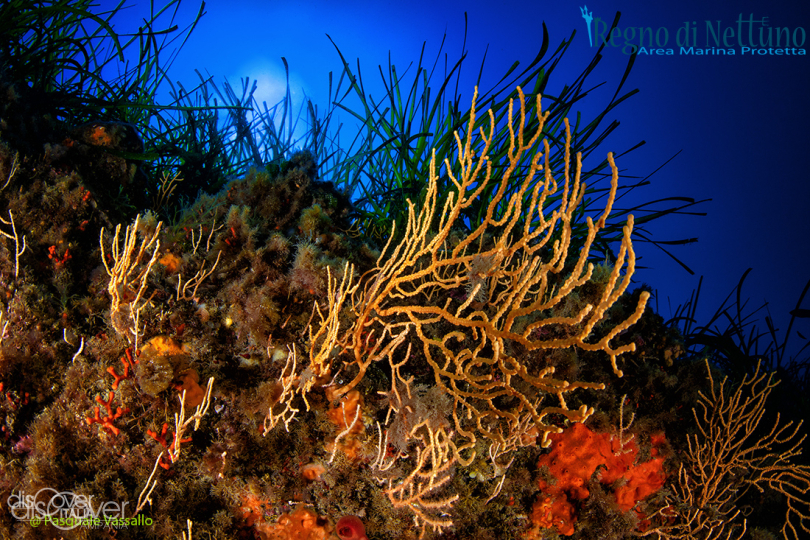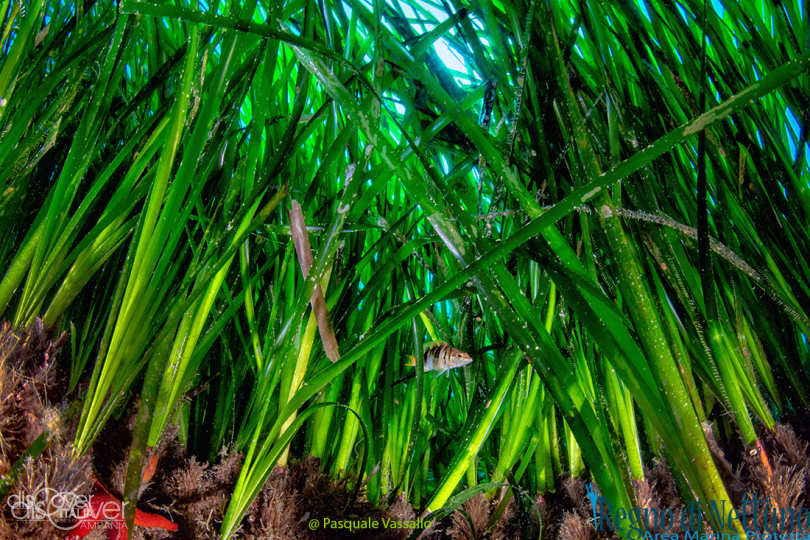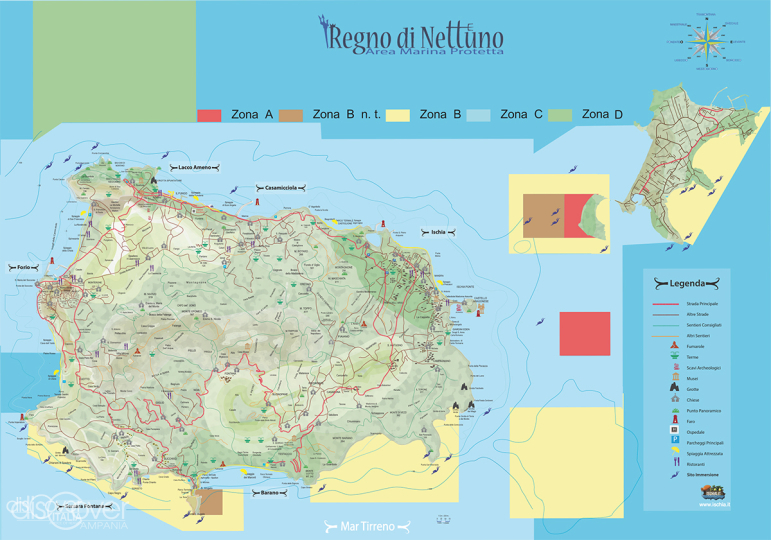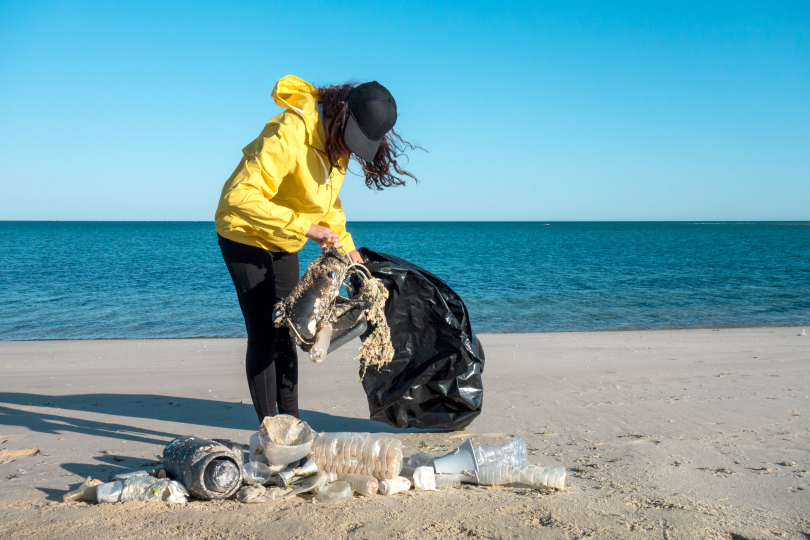With its 11,256 hectares, the one that protects the sea surrounding the Flegrean Islands is the largest of the Marine Protected Areas of Campania and one of the largest in Italy. Established in 2007, to protect the extraordinary biodiversity that characterizes the sea around Ischia and Procida both for the presence there of the "climate border" between the northern and southern Mediterranean, thanks to which plant and animal species from both areas concentrate and coexist, both for the variety of rocky and sandy substrates, as well as the existence of shallows and caves.
The rocky walls, both in the points most exposed to the light and in those most in the shade, are colonized by the most diverse species present in the Mediterranean: green and red algae to which Caulerpa (of tropical origin) racemosa, taxifolia and prolifera have been permanently added and then sponges, bryozoans, madrepores, corals and brightly colored gorgonians. Red coral formations resist both in Pizzaco, on the island of Procida, and on the volcanic rock wall of Sant'Angelo, on the island of Ischia, where the rare Gerardia savaglia, known as false black coral, is also present. And around the coral there is a great wealth of algae, invertebrates and fish. In Pizzaco, for example, calcified red algae create ideal conditions for the settlement of countless other marine creatures.
Promoting the multiplicity of species are the vast prairies of Posidonia oceanica, the marine plant of the Mediterranean, which almost entirely encircle Ischia with a "green belt" interrupted only for a stretch, to the south, and connected to the posidonia groves of Vivara and Procida on which the perimeter of the island's Marine Area is "modelled". With its 16 square kilometres, the expanse of posidonia grows both on rocky bottoms, as at Punta Imperatore and Punta Caruso, and on sandy bottoms, in front of the north and north-west coast and at San Pancrazio, passing from a minimum depth of one meter (for example between the Castle and the bay of Sant'Anna) at 30 meters.
The hydrozoans Sertularia pertusilla and Aglaophenia harpago, and bryozoans, including Electra posidoniae, live in Posidonia. And then spirorbid worms, sea squirts including the characteristic Halocinthia papillosa, actinias, starfish, sea spinners, sponges, sea cucumbers, gastropod molluscs, cephalopod molluscs such as cuttlefish and octopus, the female urchin and the hoary urchin, crustaceans such as lobsters and prawns. There are also various fish species, including salps, which feed on the leaves of the plant, minnows, serranos, pipefish, peacock fish, bream, sea bream and damsels. Zoning and activity regulations
Zoning and activity regulations The A ZONES of integral protection are the western coast of Vivara and the Secca della Catena.
The A ZONES of integral protection are the western coast of Vivara and the Secca della Catena.
Entering zones A is prohibited and all activities are prohibited, except for rescue, surveillance and service activities.
The NO TAKE B ZONES are special general reserve B zones, "strengthened" from the point of view of protection constraints, such as Punta Sant'Angelo and the spectacular Secca delle Formiche, between the Aragonese Castle and Vivara, where among the many species, exceptionally, just 13/14 meters deep lives the spectacular Axinella cannabina, a very delicate sponge which elsewhere cannot be found less than 40 metres.
It is forbidden to enter to carry out any professional or sporting fishing activity, aquaculture and militiculture. Sports scuba diving authorized by the managing body is permitted.
The general reserve ZONES B are located on the eastern coast of Procida, from Punta della Lingua to Punta Solchiaro, where all the fish species of rocky environments are found; along the entire stretch of sea surrounding Vivara; on the Banco d'Ischia, off the south-eastern coast of the island and a precious repopulation site; on the stretches in front of San Pancrazio and Scarrupata; on the stretch from Punta Imperatore to Punta Sant'Angelo in the south-western part of Ischia and on the Secca di Forio.
Bathing, diving and underwater guided tours, sailing, rowing or within certain limits defined by the regulation, access to boats (passenger and scheduled transport, authorized by the manager), mooring and anchoring in identified sites, artisanal fishing, fishing tourism, aquaculture and sport fishing.
Partial reserve ZONE C is very extensive and includes the entire sea around the islands, excluding the Procida Canal, a fundamental route for navigation, and the area north of Punta Imperatore.
The same activities as in zone B are permitted with the addition of access to pleasure boats, mooring in authorized areas and sport fishing.
ZONE D for the protection of marine mammals (two miles wide and eight miles long), which integrates a large part of the Cuma Canyon off the north-western area of Ischia into the perimeter of the park. This is the most important Cetacean Sanctuary in Italy, where seven species of cetaceans live permanently: fin whale, sperm whale, Risso's dolphin, pilot whale and, among the dolphins, bottlenose dolphin, dolphin and the very rare common dolphin (Delphinus delphis) at risk of extinction and now disappeared almost everywhere in the Mediterranean.
Most of the activities referred to in the previous points are permitted, as well as purse seine and trawl fishing (subject to authorization), sport fishing with rod and line, as well as the observation of cetaceans.
To enjoy the underwater beauty of the Kingdom of Neptune and go on excursions to the most spectacular points of the Marine Protected Area, Pietro Sorvino's Ans Diving Ischia is in Ischia Ponte in via Girolamo Rocca 13
Citizen reports
Citizen Science in the Kingdom of Neptune Marine Protected Area
Through the website www.citizenscience.org it is possible to report to the managing body marine organisms and natural phenomena of naturalistic-ecological interest for the marine environment found within the perimeter of the Marine Protected Area of the Kingdom of Neptune(islands of Ischia, Procida and Vivara, in the gulf of Naples). This is in order to improve knowledge of the habitats and inhabitants of the sea within the MPA and to report any ecological problems.
Remember that..
| TYPE OF WASTE | DEGRADATION TIME |
| Paper handkerchief | 3 months |
| Newspaper | 1 month |
| Plastic lighter | 100-1000 years |
| Cigarette butt | 1-2 years |
| Chewing gum | 5 years |
| Glass bottles | 4000 years |
| Plastic bottles | 100-1000 years |
| Carton box | 2 months |
| Diaper | 400-500 years |
| Aluminum cans | 10-100 years |
| Plastic bag | 100 -1000 years |






